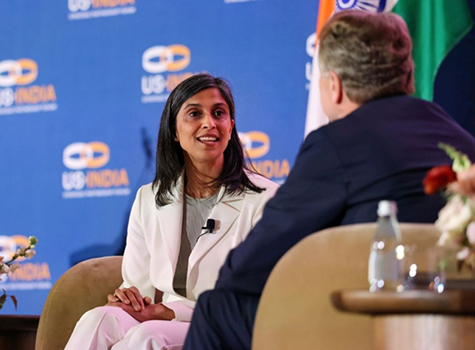
What is the divine feminine and masculine? Within Indian traditions of Sanatana Dharma, or what is commonly known as Hinduism, some may look to philosophies to say that the masculine energy is the ultimate form of the universe, while there are philosophies that note that the Devi is the underlying cause to all of creation. While there is a “Father” figure represented in the divine, the “Mother” figure also is prominent and diverse.
This concept is pervasive within the Indian arts. In Bharatanatyam dance and other classical dance forms, there is the “Bhumi Namaskar” or a prayer to Mother Earth. This prayer is conducted to ask forgiveness for stomping on her. This is a remembrance of the Earth that challenges us and to be consciously aware of our place and how we impact our surroundings. In Kuchupudi Dance, prior to the start of the dance drama, a prayer in honor to the Goddess is performed called “Amba Paraku Devi Paraku.” This is an invocation to the Goddess to bestow her blessings. The concepts of the Bhumi Namaskar and beseeching forgiveness can be applied as well in one’s daily life when determining how to make a positive impact on the Earth and all its various beings.
Going from the invocation, the beat is another concept that intertwines the masculine and feminine energies. When looking at keeping count of beats, the concept of “Thala” is utilized. Upon further examination of at the word, “Tha” is said to come from the word “Thandava” or the dance from Shiva, while “La” comes the feminine dancing of Parvathi known as “Lasya.” Bringing the hands together and separating them thus creates the essential elements for keeping beat. The symbolism of the Thala of the masculine and feminine energies can be seen in the visual representations of Ardhanarishwara where Shiva and Parvathi are merged as the halves of each other.
From the beat or Thala, one can move look at the dance form itself. Within the Natya Shastra, Shiva teaches Thandava to Saint Thandu. Thandava can be described as a masculine form of dance with plenty of jumps and crisp movements. The Thandava is made up of 108 Karanas, 32 Angahras and Rechakas.
While some may like to think of Lord Shiva as the ultimate dancer, or the Nataraja, Goddess Parvathi in her various manifestations is the equal to Lord Shiva and this is beautifully expressed in the Tamil Song, “Chinnanjiru Pen Pole,” where a line notes “pittanukku iNAIyAga narttanam ADiduvAL.” (She will dance as an equal to Lord Shiva).
A well-known dance of Lord Shiva is known as Ananda Thandava. In the song “Natanam Adinar” by Gopaalkrishna Bhaaratiyaar, the lyrics note that Shiva danced in Chidambaram as promised to the great sages in Kailasa. In one of the stories, Lord Shiva is disguised as a mendicant amongst a group of rishis in a forest. These sages believed they could control the Gods with their magic and mantras. Upon seeing the disguised Shiva’s beauty, the women became enchanted, and the sages filled with jealousy were enraged, and invoked snakes. Lord Shiva thus took the snakes and beautified himself around his body. Then the sages invoked a tiger; Lord Shiva wears the tiger on his waist. Finally, the sages invoke an asura or demon, who symbolizes arrogance and ego- Lo and Behold! Lord Shiva dances upon this arrogance.
Goddess Uma then performs the Lasya to balance the anger from Shiva. In another form of the Goddess Parvathi as Kali, she dances in her fearful form, and thus Shiva must balance her energy. While the Ananda Thandava is probably the most well-known, there are also 7 sub types of other thandava dances, one of them the Uma Thandava, depicting the love between Lord Shiva and Goddess Uma and expressed in Shringara Rasa.
In some philosophies, it is believed Lord Brahma came from Vishnu’s navel. In Devi Bhagavatham, it is believed that the entire creation is through the energies of Devi. But who is the ultimate winner? If it is noted that Goddess Parvathi is Lord Shiva’s equal, how can it be reconciled from the Urdhva Tandava when Goddess Parvathi and Lord Shiva are competing to see who is the better dancer, and she humbly declines to raise her leg in the pose due to modesty? Did Mother lose that game? If she could dance just like Lord Shiva, why did she have to become so humble? Is that anti-feminist? I believe Mother teaches so many nuanced lessons. From my interpretation, Mother demonstrates a lesson to everyone that can be applied in one’s daily life. For instance, maybe we can let someone else “win” the competition if it goes against our personal beliefs. Maybe winning at any cost is not actually winning, and sometimes, walking away from the competition is a personal win. Strength can not only be demonstrated by competing, but also knowing when not to compete. This is not something that is “black” and “white” in its analysis, or of “right” or “wrong” or “win” or “lose”, but a deeper analysis for how to approach various situations.
Maybe the divinities are teaching us various lessons as they dance, and how we interpret the message is up to us and our individual and unique paths as free thinkers.
This series of articles is about the journey and unique insights of an adult dance student learning classical Indian dance and the experiences and perspective of taking classical Indian dance as both an American and Indian.
Preethi Sriram is a classical dance enthusiast and lifelong learner of dance. Contact: SriramPreethi@hotmail.com



